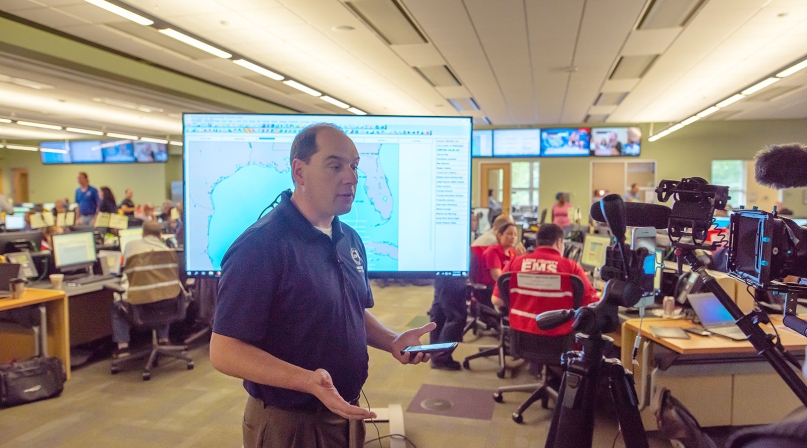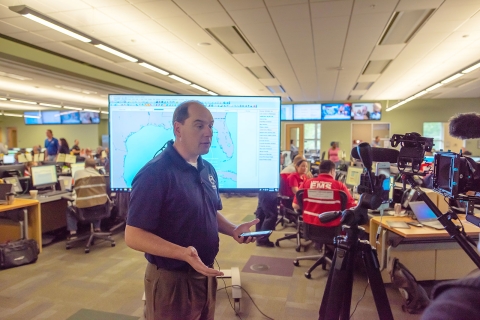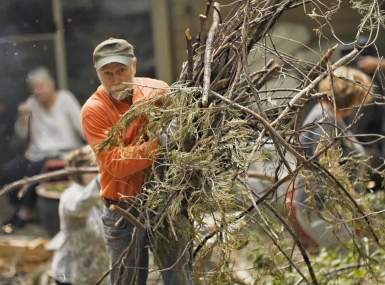Natural disaster planning takes on urgency during pandemic
Author
Upcoming Events
Related News

Lawrence County, Miss. Emergency Management Director Tony Norwood’s county was hit with not one severe weather event in April, but three — two tornadoes and a severe storm — all in the midst of the COVID-19 pandemic.
On Easter, EF3 and EF4 tornadoes struck the southern portion of the county, killing a county deputy and his wife. Later in April, in the northern portion of the county, a severe windstorm destroyed five houses.
“Our first responders, our volunteers, our fire departments, some of them had masks on to do what they needed to do, but it’s kind of hard to wear a mask trying to talk and assess folks and run a chainsaw,” Norwood said. “For about 26 hours, social distancing and COVID-19, which is not a good thing to do, but, it kind of went out the window for a little while.”
The county is working with the Mississippi Emergency Management Agency and the state department of health to obtain personal protective equipment, some of which is going to a Red Cross-affiliated shelter in the county where masks are required.
“COVID-19 has changed everything,” he said. “We’re trying to re-write our comprehensive emergency management plan as we go.”
Hurricanes
Ahead of hurricane season, Leon County, Fla. Emergency Management Director Kevin Peters said the county is working with the state’s division of emergency management, the FEMA regional office and the state’s emergency management association to discuss changes to shelter operations.
New measures at shelters may include entrance screening, taking temperatures, using CDC guidance for health questionnaires and creating isolation areas for those who may present COVID-19 symptoms.
When it comes to providing long-term shelters for individuals who have lost their homes, Peters said the county is holding conversations with the Red Cross to discuss shelter options in a post-storm environment while dealing with COVID-19. New criteria may include a cap on the number of people per square foot. The county is also working on plans to allocate personal protective equipment for those in shelters.
“There is no question that the coronavirus will change how Florida and Leon County shelter vulnerable populations,” said Leon County Commission Chairman Bryan Desloge. “But what won’t change is our county’s commitment to keeping our community safe in the face of a storm.”
Peters predicts challenges with some individuals who may be less willing to evacuate during a hurricane.
“They may fear not knowing where to go or have a fear of going to a shelter,” he said. “We hope that individuals make good plans and take time to think about what they’re going to do if a disaster affects their community.”
Whenever the county is hit by a hurricane, Peters said the department reviews plans and obtains recommendations for future disasters.
“It’s kind of the silver lining to the COVID-19 experiences… it’s given us a chance to develop newer plans and lessons learned that we can apply with respect to coordinating,” he said.
In Broward County, Fla., Regional Emergency Services and Communications Director Tracy Jackson said the main difference preparing for this hurricane season with the pandemic is dealing with individuals who are COVID-19 positive being in close proximity to each other following a hurricane.
“We plan on using social distancing as well as masks and gloves to help provide as much protection as possible,” he said.
Wildfires
Sonoma County, Calif. Director of Emergency Management Chris Godley said his department turns to concurrent hazard planning ahead of fire season with an overlapping event such as COVID-19.
“We’ve never operated with a potential set of national hazards compounded by manmade hazards like power shutoffs against the backdrop of a global pandemic,” he said. “This is new territory for almost everyone.”
Last year, Godley said the county prepared for two concurrent threats with fires and power shutoffs. The county worked to find ways to alert residents about the spread of fires with loss of power.
“This year, we’re looking at taking both those hazards and bringing in that third one, of COVID-19,” he said. “The COVID-19 complications require us to do a lot more detailed planning and forces us to change the way we’re going to respond to the event.”
When it comes to power shutoffs during the pandemic, Godley said he is working with the California Public Utilities Commission to ensure that power remains on at hospitals.
He referenced potential complications during the pandemic, such as providing warnings to the public now that people are using different communication systems such as Zoom calls.
“I can’t insert a warning message into an internet streaming device,” he said.
If evacuations are necessary, Godley said he sees challenges with the lack of resources and mutual aid as well as safely finding ways to evacuate individuals whose health may be compromised and they are breathing in smoke.
The county is looking at more diverse shelter options so fewer people are housed in each location and can practice social distancing. For those who may have COVID-19-related symptoms, hotels are being considered rather than a congregate shelter.
Godley said he anticipates more individuals will need to stay at community shelters because they won’t be able to stay with friends or family, over health concerns.
Currently, the planning focus is aimed at evacuating larger areas earlier and creating more resources to care for individuals after they’re forced out of their home, he said.
“Our model for disaster response is to slow resources from unaffected areas into affected or impacted areas, that includes nonprofits, government organizations, volunteers,” he said. “We do believe that is going to be somewhat limited this year.”
Godley said the county is focusing on spreading the message of preparedness to residents because “their ability to fall back on large institutional resources may not be an option.”
“We need our residents to understand that this next time around if we have a COVID-19 wave coming and they turn off the power and if a fire starts, it could be really challenging,” Godley said.
Godley said the long-term effects of COVID-19 on fiscal health will have a significant impact on public safety.
“We’re going to need real resources to ensure that as our communities are lacking resources because of COVID-19 to respond, that we are in the position to step in and support them,” he said.
FEMA’s Public Assistance Program provides funding to local governments for emergency measures related to COVID-19. The agency uses an online information technology tool called the PA Grants Portal that can be accessed at https://grantee.fema.gov.

Attachments
Related News

White House launches federal flood standard support website and tool
On April 11, the White House launched a new website and mapping tool to help users with the ongoing implementation of the Federal Flood Risk Management Standard (FFRMS).

As disasters increase, counties must invest in mitigation
Disasters are becoming more frequent, more severe and more costly, and counties, parishes and boroughs are on the front lines — where the immediate response is handled and where the personal impact is felt.

Micro-grants help fireproof a neighborhood by reducing fuel
Nevada County, Calif. helped communities reduce the vegetation that could easily spread fire in neighborhoods.
